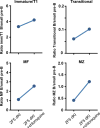Host controls of HIV broadly neutralizing antibody development
- PMID: 28133807
- PMCID: PMC5479487
- DOI: 10.1111/imr.12508
Host controls of HIV broadly neutralizing antibody development
Abstract
Induction of broadly neutralizing antibodies (bNAbs) is a major goal of HIV vaccine development. BNAbs are made during HIV infection by a subset of individuals but currently cannot be induced in the setting of vaccination. Considerable progress has been made recently in understanding host immunologic controls of bNAb induction and maturation in the setting of HIV infection, and point to key roles for both central and peripheral immunologic tolerance mechanisms in limiting bnAb development. Immune tolerance checkpoint inhibition has been transformative in promotion of anti-tumor CD8 T-cell responses in the treatment of certain malignancies. Here, we review the evidence for host controls of bNAb responses, and discuss strategies for the transient modulation of immune responses with vaccines toward the goal of enhancing germinal center B-cell responses to favor bNAb B-cell lineages and to foster their maturation to full neutralization potency.
Keywords: AIDS; B cells; autoantibodies; autoimmunity; vaccination.
© 2017 John Wiley & Sons A/S. Published by John Wiley & Sons Ltd.
Conflict of interest statement
The authors certify that they have no conflict of interest with regard to the content and conclusions of this manuscript.
Figures


References
-
- Haynes BF, Fleming J, St Clair EW, et al. Cardiolipin polyspecific autoreactivity in two broadly neutralizing HIV-1 antibodies. Science. 2005;308:1906–1908. - PubMed
Publication types
MeSH terms
Substances
Grants and funding
LinkOut - more resources
Full Text Sources
Other Literature Sources
Medical
Research Materials

